By Chris Lent, NCAT Agriculture Specialist
I’ve always found ways to turn “waste materials” into useful resources on the farm fascinating. On my farm, I tried to reuse and recycle resources as much as possible to close the off-farm input loop. I think farms can become more resilient as they rely on fewer off farm inputs. So, when I heard of the mid-scale anaerobic digester being installed at Dickenson College Organic Farm as a demonstration of how small dairy farms can utilize manure and other waste streams to produce on farm energy, I was eager for the opportunity to visit the farm and help spread the word to other farms.
In November 2023, NCAT Agriculture Specialist Eric Fuchs-Stengel and I had that opportunity. We traveled to Dickenson College Organic Farm in Carlisle, PA to visit Matt Steiman, Farm Energy and Livestock Manager at the farm. The farm is a beautiful certified organic working farm situated on 90 acres in the south-central part of the state where they grow vegetables and raise beef, lamb, and layers. Eric and I were there to shoot a video tour of the newly installed, mid-scale anaerobic biodigester that transforms manure from a neighboring dairy, as well as food waste from the college dining hall and local restaurants, into natural gas that can be used to generate heat and electricity.
This biodigester project comes after years of biofuel research and experimentation by Steiman at the college. The idea of using waste products from the farm and local area to produce fuel and power greatly intrigued Steiman, so he started making biodiesel that converted waste cooking oil into fuel to run equipment on the farm. Since the glycerin byproduct from biodiesel production can be useful in anaerobic digestion of organic matter that produces natural gas, he started experimenting in 2010 with small anaerobic digester systems to utilize glycerin, leading to a series of larger systems and culminating with the latest farm-scale biodigester.
The process of anaerobic digestion for production of natural gas is straightforward. A sealed tank creates an anaerobic, or oxygen-free, environment where a slurry of organic matter can be “eaten” or digested by microbes that thrive at certain temperatures in low-oxygen conditions. The methane gas given off from the microbes in this process rises to the top of the tank to an outlet tube where it can be collected and used as a fuel source for heat or electric production. The leftover digestate, which contains all the nutrients from the original waste material, is collected and spread on farm fields.
The size and cost of this new biodigester project required very specific design considerations to ensure that it was sized properly to match the expected waste flow and operate as intended. The digester tank is a 10-foot tall, 115,000-gallon, 50-foot-diameter cement tank buried 8 feet in the ground and sealed with a heavy-duty rubber covering. In the tank are heater pipes and an agitator to mix the slurry. A free-style barn was built next to the tank to house the dairy cows and heifers. At one end of the barn are three in-ground cement tanks that make up the waste-collection system for the digester. One tank is for daily manure collection, the second is for food waste collection (up to 3 tons per day), and the third is for collecting the digestate material remaining after the digestion process. The digestate goes through a liquid removal process and can then be used for bedding in the barn. The liquid portion of the digestate is staged to be used as a nutrient source for the farm’s crop fields and compost piles.
This digester is sized to produce enough gas to match a 50-kilowatt (kW) combined heat and power (CHP) engine. An engine from the European company TEDOM adapted to biogas was chosen for the job. The power produced will first be used to supply the power needs of the farm and the biodigester itself with excess electric production being sold back to the local utility company. This unique 150-cow-scale digester is small compared to other on farm digesters in the United States.
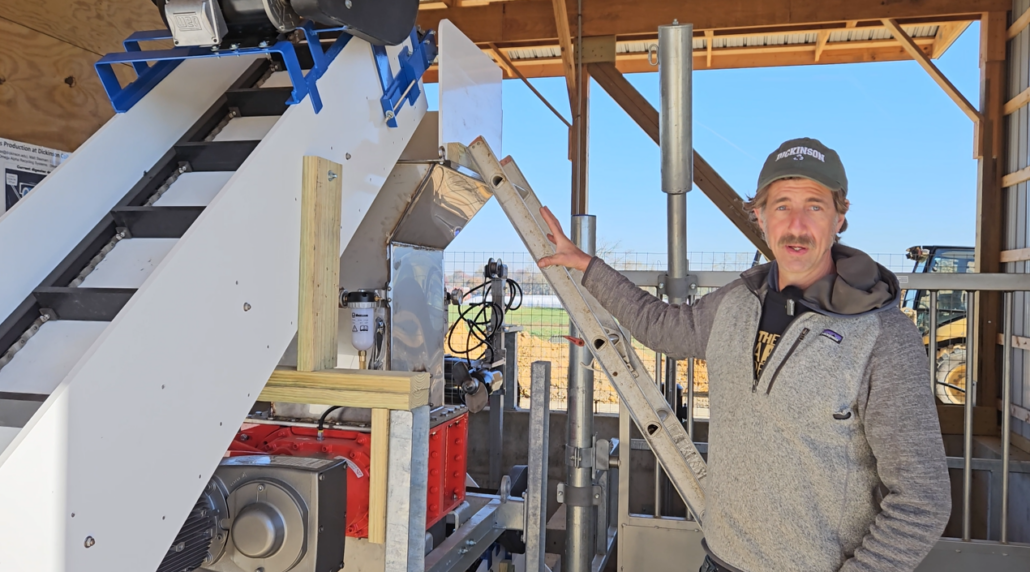
Matt Steiman explaining how an industrial grinder works to break down up to 3 tons of food waste a day so it can be pumped to the digester tank. Photo: NCAT
Funding for this project was secured from multiple sources, including NRCS’s Environmental Quality Incentives Program (EQIP). For farmers looking for biodigester funding, Steinman had several suggestions. First, he said, talk to your Natural Resources Conservation Service (NRCS) county office. In addition, the Rural Energy for America Program (REAP) is a grant program administered through USDA’s Rural Development office. Through REAP, farmers and rural businesses who meet grant criteria can apply for grant funding up to 50% of the cost of an on-farm alternative energy project, including anaerobic biodigesters. Steiman also suggested talking to your state Department of Agriculture and Department of Environmental Management or Protection as funding sources. It is also worth investigating local conservation districts and utility companies that may offer funding for on-farm alternative energy projects.
With this new biodigester, Steiman and Dickenson College are using farm and food-waste streams to generate renewable energy right on the farm and reduce greenhouse gas emissions. With nearly 5,000 dairy farms in Pennsylvania alone with an average herd size of 100 cows, this project is intended to showcase how biogas production can work for mid-sized farms across the state and the country. The college is partnering with Penn State University and agriculture producer groups like PASA Sustainable Agriculture to use this project as an on-the-ground demonstration of properly sized biodigester design and implementation and to educate farmers on the benefits of biogas production at this scale.
Related ATTRA Resources:
Episode 350. Mid-Scale Biodigester with Matt Steiman of Dickinson College
Biodiesel Use, Handling, and Fuel Quality
Micro-Scale Biogas Production: A Beginners Guide
Anaerobic Digestion of Animal Wastes: Factors to Consider
Other Resources:
Biogas – Dickinson College Organic Farm
Organic Farm Dickinson College – YouTube
On-Farm Energy Initiative, NRCS
This blog is produced by the National Center for Appropriate Technology through the ATTRA Sustainable Agriculture program, under a cooperative agreement with USDA Rural Development. ATTRA.NCAT.ORG.

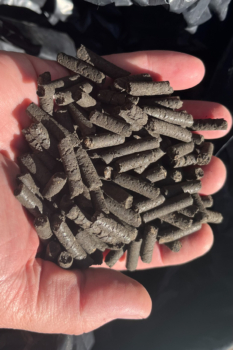 To contend with these issues, the project composts the poultry litter and combines it with biochar made from forest and sawmill waste and poultry litter. The result is a soil conditioner to help farmers build healthy soil and reduce the application of expensive fertilizers that can harm the Arkansas River watershed.
To contend with these issues, the project composts the poultry litter and combines it with biochar made from forest and sawmill waste and poultry litter. The result is a soil conditioner to help farmers build healthy soil and reduce the application of expensive fertilizers that can harm the Arkansas River watershed.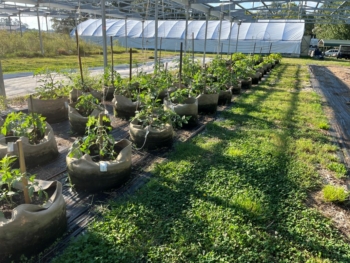 Right now, Hardin is working on securing project funding while creating an 11-acre carbon innovation and demonstration farm that can serve as a research facility for the Carbon Chicken Project—and to get other agricultural partners on board.
Right now, Hardin is working on securing project funding while creating an 11-acre carbon innovation and demonstration farm that can serve as a research facility for the Carbon Chicken Project—and to get other agricultural partners on board.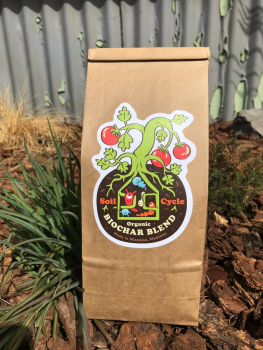 A small local houseplant business contacted Soil Cycle because they wanted a soil amendment that could hold nutrients and water while having a fluffy texture for potted succulents. After doing some research, Lewis learned about biochar and found a partner in Bad Goat Forest Products. This Missoula-based company builds live edge furniture, timber frame, and log shelters using wood sourced from local forest restoration and urban tree removal projects.
A small local houseplant business contacted Soil Cycle because they wanted a soil amendment that could hold nutrients and water while having a fluffy texture for potted succulents. After doing some research, Lewis learned about biochar and found a partner in Bad Goat Forest Products. This Missoula-based company builds live edge furniture, timber frame, and log shelters using wood sourced from local forest restoration and urban tree removal projects.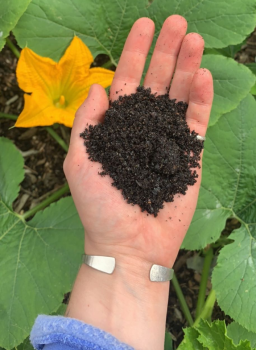 To replicate partnerships like Soil Cycle and Bad Goat Lumber’s and scale up biochar production for use in agriculture and forestry, the country needs a coordinated research program to inform farmers, ranchers, foresters, and gardeners on which types of biochar will work in their conditions. Congress is crafting the 2023 Farm Bill, which presents a big opportunity to ensure the promise of biochar is realized.
To replicate partnerships like Soil Cycle and Bad Goat Lumber’s and scale up biochar production for use in agriculture and forestry, the country needs a coordinated research program to inform farmers, ranchers, foresters, and gardeners on which types of biochar will work in their conditions. Congress is crafting the 2023 Farm Bill, which presents a big opportunity to ensure the promise of biochar is realized.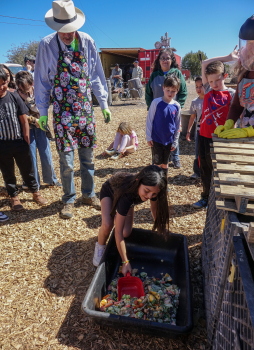
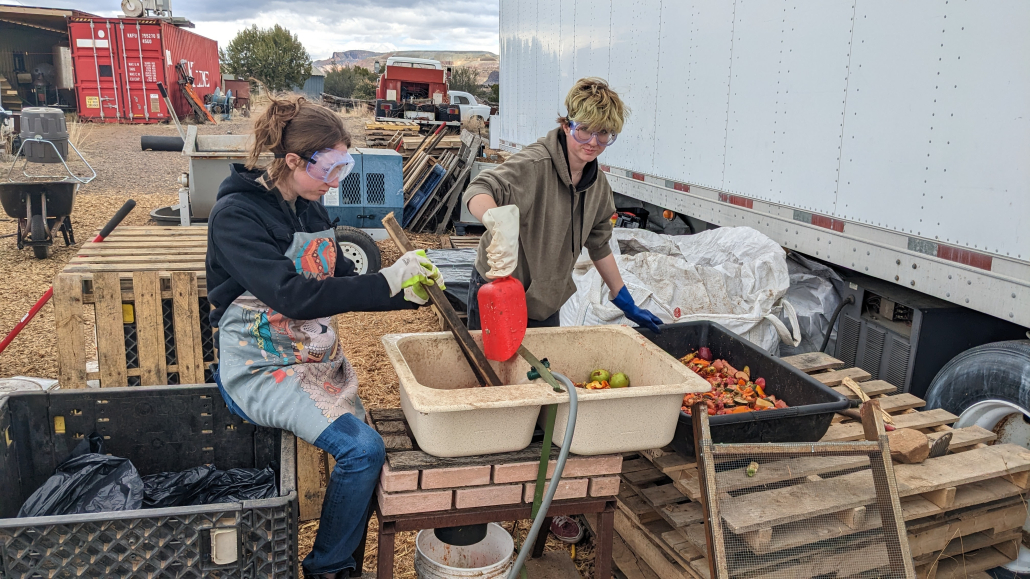
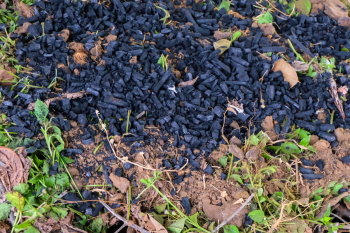 If you have ever stared into the coals of a fire pit, you have witnessed the powerful chemical reaction between heat and organic matter. But what if the blackened remains of a bonfire could be used to grow better food, prevent catastrophic wildfires, and slow the acceleration of climate change?
If you have ever stared into the coals of a fire pit, you have witnessed the powerful chemical reaction between heat and organic matter. But what if the blackened remains of a bonfire could be used to grow better food, prevent catastrophic wildfires, and slow the acceleration of climate change? “We were trying to turn that waste material into an asset, and so my approach changed from making biochar to making heat with biochar as a co-product,” he said.
“We were trying to turn that waste material into an asset, and so my approach changed from making biochar to making heat with biochar as a co-product,” he said.